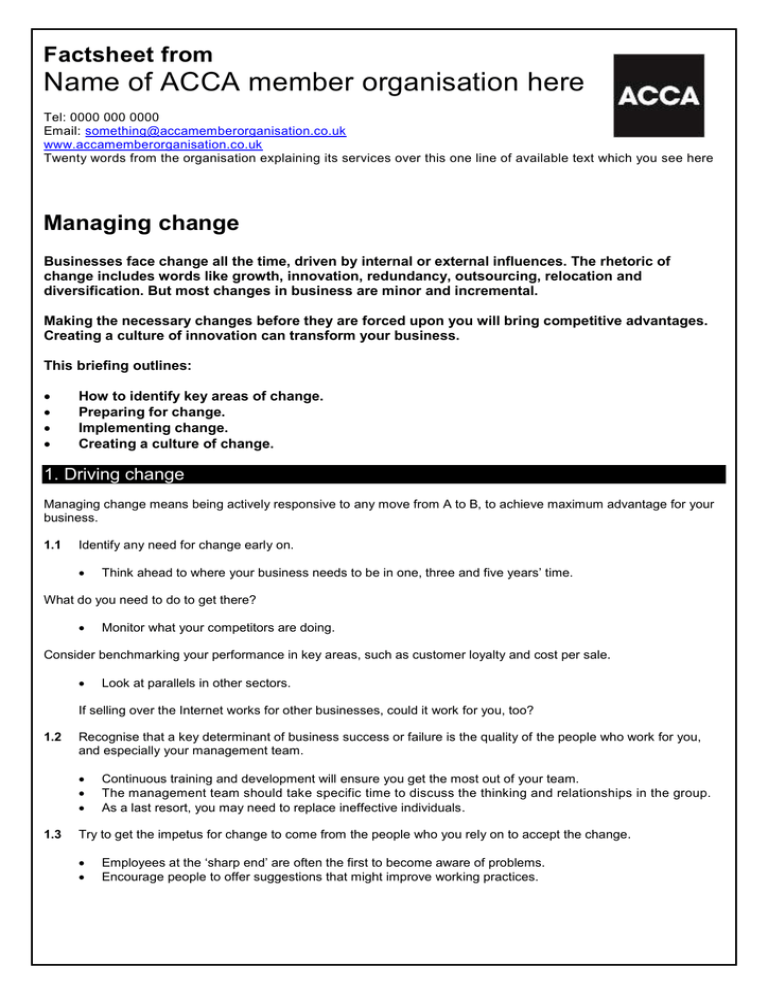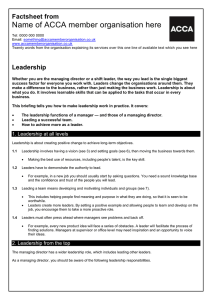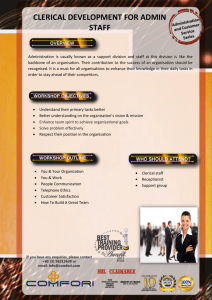
Factsheet from
Name of ACCA member organisation here
Tel: 0000 000 0000
Email: something@accamemberorganisation.co.uk
www.accamemberorganisation.co.uk
Twenty words from the organisation explaining its services over this one line of available text which you see here
Managing change
Businesses face change all the time, driven by internal or external influences. The rhetoric of
change includes words like growth, innovation, redundancy, outsourcing, relocation and
diversification. But most changes in business are minor and incremental.
Making the necessary changes before they are forced upon you will bring competitive advantages.
Creating a culture of innovation can transform your business.
This briefing outlines:
How to identify key areas of change.
Preparing for change.
Implementing change.
Creating a culture of change.
1. Driving change
Managing change means being actively responsive to any move from A to B, to achieve maximum advantage for your
business.
1.1
Identify any need for change early on.
Think ahead to where your business needs to be in one, three and five years’ time.
What do you need to do to get there?
Monitor what your competitors are doing.
Consider benchmarking your performance in key areas, such as customer loyalty and cost per sale.
Look at parallels in other sectors.
If selling over the Internet works for other businesses, could it work for you, too?
1.2
Recognise that a key determinant of business success or failure is the quality of the people who work for you,
and especially your management team.
1.3
Continuous training and development will ensure you get the most out of your team.
The management team should take specific time to discuss the thinking and relationships in the group.
As a last resort, you may need to replace ineffective individuals.
Try to get the impetus for change to come from the people who you rely on to accept the change.
Employees at the ‘sharp end’ are often the first to become aware of problems.
Encourage people to offer suggestions that might improve working practices.
People are more likely to accept a proposed change if they have felt engaged and fully informed along the
way.
Effective change management depends largely on your leadership skills.
2. Prioritising change
2.1
Decide which changes are most important.
2.2
Focus on the changes with the biggest potential benefits, not the easiest ones to implement.
Programme continual smaller changes rather than a few large ones.
Too many large changes are hard to digest and can interfere with one another.
Small scale changes are easier to manage.
Continual successful changes breed a positive culture of change (see 7).
3. Preparing for change
3.1
Make sure the reasons for change are in line with your overall business objectives.
3.2
Obtain reliable performance measures in the area undergoing change.
3.3
Any support for the change will be minimal if people do not understand its purpose. For example, some
health and safety initiatives might appear to employees to be pure bureaucracy.
Check that the planned change is SMART — specific, measurable, agreed, realistic and time-limited. Keep it
simple.
For example, sound data on sales or customer satisfaction will give you a clear picture of how much change
is needed.
Baseline figures will let you measure the effect of any change you then make.
Consider both personal and business implications. The end objective can seem so desirable that important
details are overlooked.
Change usually involves extra work and extra expense.
Is your cashflow strong enough, or will you need to borrow?
Will the management structure need to be adjusted?
Does the management team have enough spare capacity to manage the change? Lack of focus, time
and attention can result in failure.
Individual skills and experience may become redundant. New initiatives may need new teams to manage them.
Will existing skill levels be adequate?
You may need to recruit new employees or arrange training. For example, if you are setting up a website for the first
time.
3.4
Make sure that other systems and policies are compatible with the planned change.
3.5
Will people feel intimidated when faced with new technology?
Will your employees' personal lives be disrupted by a change in hours?
For example, if your priority is to improve quality, an existing incentive scheme which rewards cost cutting
may undermine your drive for improvement.
Change usually involves going into unknown territory, but others will have been there first. Take advice.
2
Talk to business associates.
Learn from the experience of anyone who has made similar changes.
Many management consultants specialise in particular types of change, such as company mergers or
downsizing.
Some consultants are experienced in change generally and can provide a key additional management resource.
3.6
If a planned change is risky, explore and pilot it before full-scale implementation.
3.7
Evaluate the results and make any adjustments needed.
Set up a timetable for change, to focus people’s minds.
Phasing in change is preferable and allows any problems to be addressed early on.
4. Selling the change
Whatever the area of change, you will need the co-operation of the people who are affected and who you rely on.
4.1
Resistance is the biggest stumbling block to successful change. Sources of resistance include:
Natural wariness of change. Do not underestimate people’s fear of change.
For example, acknowledge that employees may not want to give up familiar and long-established working patterns.
Cynicism about ‘flavour of the month’ changes.
Most people have had experience of initiatives that caused considerable extra work but eventually came to nothing.
4.2
Misunderstanding, when people are not told enough or think there is a hidden agenda.
You are implementing change for a good reason. You should be able to sell your idea to the people affected.
Explain the benefits.
Make people understand the cost of not changing.
For example, losing customers or keeping costs artificially high — and eventually being forced to downsize.
Point to examples of successful change in the past by you or your competitors.
Avoid overselling the benefits. Stick to what is achievable, to maintain your credibility.
4.3
Set up a thorough communication process. Rumours will develop quickly if there is a lack of information.
Give important news in person, followed by confirmation and details in writing.
Start communicating early, as people take time to come to terms with change.
But avoid communicating half-formed ideas, as this may simply cause confusion.
Allow time for feedback and reasoned objections.
Listen to the views of any sceptics — they may help you avoid costly mistakes.
Be prepared to be unpopular.
If the change is for the good of the business, employees will benefit eventually.
3
Be positive, even where change is driven from outside. People will take their lead from your attitude.
4.4
Talk to everyone who will be affected. Resentment will grow if people feel left out.
For example, inform customers and suppliers, as well as those who work for you.
Make sure everyone knows his or her role in the change process.
Encourage people to get actively involved and ‘own’ the change.
4.5
Address concerns. Spell out the implications of change for everyone.
4.6
For example, revisions to job descriptions, increased workloads or any redundancies.
Be clear about how the change will affect individuals, teams and the whole business.
Your biggest allies can be your cynics.
Do not be put off by their style — they often know the pitfalls and difficulties. If you can persuade them, persuading
other people becomes easier.
4.7
Get help from the early converts in selling to the cynics.
Do not leave any doubt that the change will happen.
Once people are certain that it is going ahead, they begin to come to terms with the inevitable.
Any change usually creates winners and losers. One person may be made redundant, while another is promoted.
Change may lead to stress, tears, resentment, accusations etc.
Professional and sensitive communication will reduce the impact this has on the business.
5. Implementing change
5.1
Make some bold early moves to let people know that change is really happening.
5.2
For example, if you are upgrading standards in customer service, you might implement a new scheme to
reward staff delivering exceptional customer care.
Assign responsibility for change.
Major changes should be the responsibility of the managing director.
Make everyone aware of what is expected of them. Include ‘contribution to change’ in employees’
performance appraisals.
Consider using a new appointee to take responsibility for the change programme.
A new face can act as a catalyst for change and can bring in key new skills.
5.3
Continue communicating the reasons for and benefits of change.
If the change strategy is right, these should become more and more clear.
5.4
Monitor progress against the original plans.
5.5
Tackle problems or obstacles as soon as they arise.
5.6
If individuals are slowing the change process, find out why and take steps to resolve the problems.
Be consistent and make sure all management actions support the change.
4
6. Making change stick
6.1
Be resolute in carrying changes through.
6.2
Keep monitoring and reinforcing the change.
Point out the benefits achieved from the change and how the business has moved on.
7. Create a culture of change
If change is seen as the norm, people will become less resistant to it.
7.1
Recognise that any system or process can be improved.
7.2
For example, the amount of paperwork can almost always be reduced.
Encourage continuous input from the people who are affected by change.
Ask for suggestions on new areas for improvement.
Give feedback and credit for any ideas implemented.
Reward people for their contribution to success.
Tie the rewards explicitly to the achievement of the planned changes.
7.3
Remember that change rarely means a move from one steady state to another.
You should continually look to identify the next opportunity for development, even as previous changes are
being implemented.
The human touch
Even small changes can backfire if they are not handled sensitively. The key to successfully managing change is to
keep people informed.
A.
Consult with those affected before implementing any changes.
You avoid the risk of trampling on peoples’ feelings and being seen as a ‘dictator’.
Those involved may be able to suggest alternatives that deliver the same results more effectively or cheaply.
People are more likely to accept change if they suggested it in the first place.
By listening to and incorporating peoples’ comments you encourage a feeling of teamwork and ownership.
Under EU rules, businesses with more than 50 employees, including agency workers, have to notify and discuss with
their employees any changes likely to affect their jobs. Penalties for non-compliance can be severe.
B.
Provide advance warning of the impending change.
C.
Give staff time to come to terms with the changes.
Advance notice allows time to make any necessary preparations or adjustments.
Monitor the impact of your changes.
You may be alerted to problems that were overlooked during the consultation process.
You can adapt and refine your changes to deliver improved results.
You may receive suggestions for further changes inspired or necessitated by your initial changes.
Factors driving change
There are thousands of influences making change in business inevitable.
5
A.
Factors from outside the business include:
B.
Technological progress, such as advances in IT.
Changing market conditions, such as supplier price increases and demand from customers for new services.
Legislation, such as age discrimination and the end of the default retirement age.
Factors from inside the business include:
Personnel changes, such as key employees leaving and new senior appointments.
New management processes or production techniques, such as customer service initiatives or offshoring.
There is a constant need to cut costs and improve efficiency to remain competitive.
Experts’ quotes
"One of the greatest motivators for change is personal interest. If change is aligned to the needs and goals of
employees at all levels it will take little effort to sell it."
Graham Wilson,
Leadership and Organisation Development specialist
"Change is much easier when it is led strongly by a team with a clear and shared vision. It’s well worth putting the effort
first into building a highly motivated team that has the trust and respect of the staff and other management."
Philippa Dickenson,
The Thinking Partnership
Expert contributors
Thanks to Graham Wilson (Leadership and Organisation Development coach/mentor, 07785 222380,
www.grahamwilson.org); Philippa Dickenson (The Thinking Partnership, 01993 880304).
Further Help
Last updated 01.12.11
© Atom Content Marketing 2010. ISSN 1369-1996. All rights reserved. No part of this publication may be reproduced or transmitted without the
written permission of the publisher. This publication is for general guidance only. The publisher, expert contributors and distributor disclaim all liability
for any errors or omissions. Consult your local business support organisation or your professional adviser for help and advice.
6



